10.E: Magnetism (Exercise)
( \newcommand{\kernel}{\mathrm{null}\,}\)
Conceptual Questions
11.1: Magnets
1. Volcanic and other such activity at the mid-Atlantic ridge extrudes material to fill the gap between separating tectonic plates associated with continental drift. The magnetization of rocks is found to reverse in a coordinated manner with distance from the ridge. What does this imply about the Earth’s magnetic field and how could the knowledge of the spreading rate be used to give its historical record?
11.3: Magnetic Fields and Magnetic Field Lines
2. Explain why the magnetic field would not be unique (that is, not have a single value) at a point in space where magnetic field lines might cross. (Consider the direction of the field at such a point.)
3. List the ways in which magnetic field lines and electric field lines are similar. For example, the field direction is tangent to the line at any point in space. Also list the ways in which they differ. For example, electric force is parallel to electric field lines, whereas magnetic force on moving charges is perpendicular to magnetic field lines.
4. Noting that the magnetic field lines of a bar magnet resemble the electric field lines of a pair of equal and opposite charges, do you expect the magnetic field to rapidly decrease in strength with distance from the magnet? Is this consistent with your experience with magnets?
5. Is the Earth’s magnetic field parallel to the ground at all locations? If not, where is it parallel to the surface? Is its strength the same at all locations? If not, where is it greatest?
11.4: Magnetic Field Strength- Force on a Moving Charge in a Magnetic Field
6. If a charged particle moves in a straight line through some region of space, can you say that the magnetic field in that region is necessarily zero?
11.5: Magnetic Force on a Current-Carrying Conductor
7. Draw a sketch of the situation in the figure showing the direction of electrons carrying the current, and use RHR-1 to verify the direction of the force on the wire.
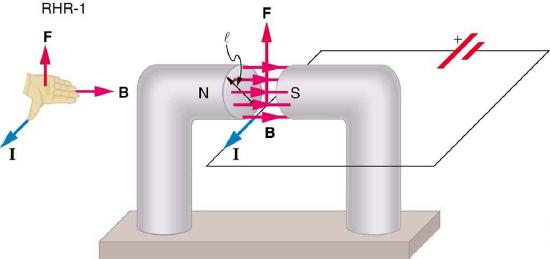
8. Verify that the direction of the force in an MHD drive, such as that in the figure, does not depend on the sign of the charges carrying the current across the fluid.
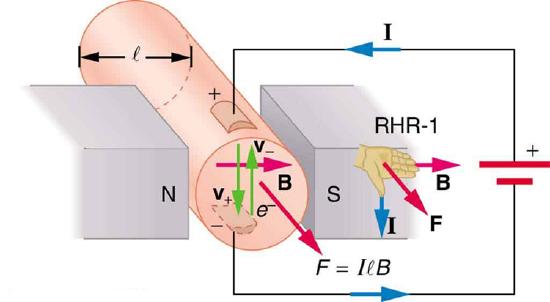
9. Why would a magnetohydrodynamic drive work better in ocean water than in fresh water? Also, why would superconducting magnets be desirable?
10. Which is more likely to interfere with compass readings, AC current in your refrigerator or DC current when you start your car? Explain.
11.8: Induced Voltage and Magnetic Flux
11. How do the multiple-loop coils and iron ring in the version of Faraday’s apparatus shown in the figure enhance the observation of induced voltage?
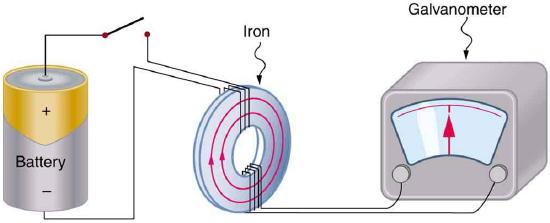
12. When a magnet is thrust into a coil as in figure (a), what is the direction of the force exerted by the coil on the magnet? Draw a diagram showing the direction of the current induced in the coil and the magnetic field it produces, to justify your response. How does the magnitude of the force depend on the resistance of the galvanometer?
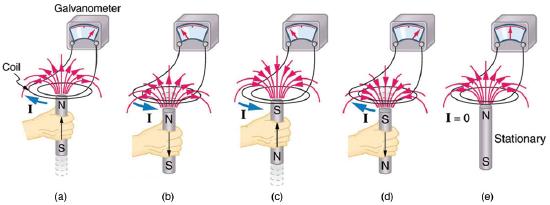
13. Explain how magnetic flux can be zero when the magnetic field is not zero.
14. Is a voltage induced in the coil in the figure when it is stretched? If so, state why and give the direction of the induced current.

11.9: Faraday’s Law of Induction- Lenz’s Law
15. A person who works with large magnets sometimes places her head inside a strong field. She reports feeling dizzy as she quickly turns her head. How might this be associated with induction?
16. A particle accelerator sends high-velocity charged particles down an evacuated pipe. Explain how a coil of wire wrapped around the pipe could detect the passage of individual particles. Sketch a graph of the voltage output of the coil as a single particle passes through it.
11.11: Alternating Current versus Direct Current
17. Give an example of a use of AC power other than in the household. Similarly, give an example of a use of DC power other than that supplied by batteries.
18. Why do voltage, current, and power go through zero 120 times per second for 60-Hz AC electricity?
19. You are riding in a train, gazing into the distance through its window. As close objects streak by, you notice that the nearby fluorescent lights make dashed streaks. Explain.
Problems & Exercises
11.4: Magnetic Field Strength- Force on a Moving Charge in a Magnetic Field
20. What is the direction of the magnetic force on a positive charge that moves as shown in each of the six cases shown in the figure? Note that ⊙⊙ indicates "coming out of the page" and ⊗⊗ means "going into the page."
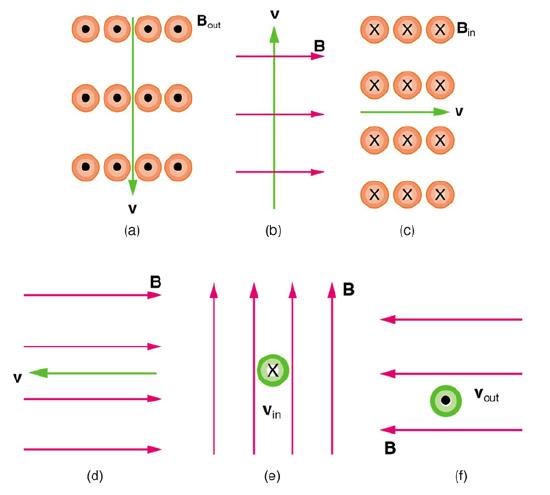
Solution
(a) Left (West)
(b) Into the page
(c) Up (North)
(d) No force
(e) Right (East)
(f) Down (South)
21. Repeat Exercise 11.4.20 for a negative charge.
22. What is the direction of the velocity of a negative charge that experiences the magnetic force shown in each of the three cases in the figure, assuming it moves perpendicular to B ? Note that ⊙⊙ indicates "coming out of the page" and ⊗⊗ means "going into the page."
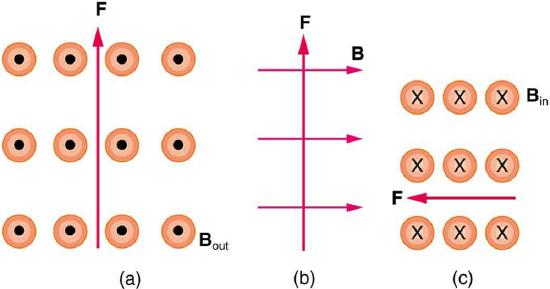 Figure 10.E.7
Figure 10.E.7Solution
(a) East (right)
(b) Into page
(c) South (down)
23. Repeat Exercise 11.4.21 for a positive charge.
24. What is the direction of the magnetic field that produces the magnetic force on a positive charge as shown in each of the three cases in the figure below, assuming B is perpendicular to v? Note that ⊗⊗ means "going into the page."
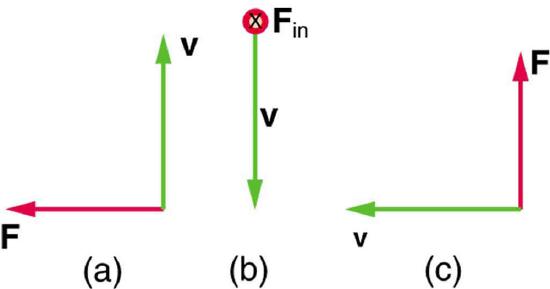
Figure 10.E.8
Solution
(a) Into page
(b) West (left)
(c) Out of page
25. Repeat Exercise 11.4.24 for a negative charge.
26. What is the maximum force on an aluminum rod with a 0.100−μC charge that you pass between the poles of a 1.50-T permanent magnet at a speed of 5.00 m/s? In what direction is the force?
Solution
7.50×10−7 N perpendicular to both the magnetic field lines and the velocity
27. (a) Aircraft sometimes acquire small static charges. Suppose a supersonic jet has a 0.500−μC charge and flies due west at a speed of 660 m/s over the Earth’s south magnetic pole, where the 8.00×10−5−T magnetic field points straight up. What are the direction and the magnitude of the magnetic force on the plane? (b) Discuss whether the value obtained in part (a) implies this is a significant or negligible effect.
11.5: Magnetic Force on a Current-Carrying Conductor
28. What is the direction of the magnetic force on the current in each of the six cases in the figure? Note that ⊙⊙ indicates "coming out of the page" and ⊗⊗ means "going into the page."
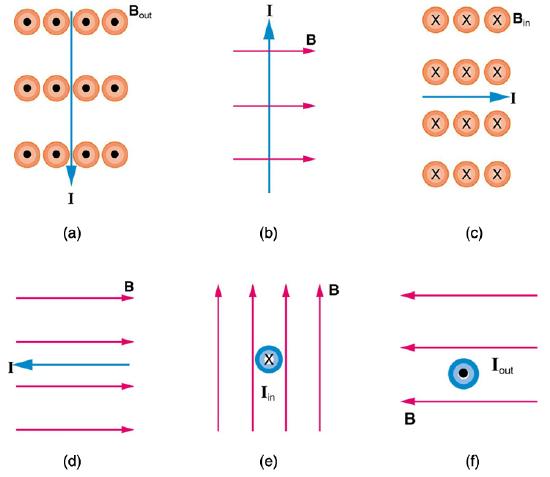
Figure 10.E.9
Solution
(a) west (left)
(b) into page
(c) north (up)
(d) no force
(e) east (right)
(f) south (down)
29. What is the direction of a current that experiences the magnetic force shown in each of the three cases in the figure, assuming the current runs perpendicular to B? Note that ⊙⊙ indicates "coming out of the page" and ⊗⊗ means "going into the page."
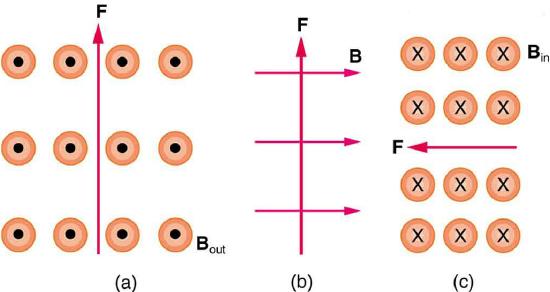
Figure 10.E.10
30. What is the direction of the magnetic field that produces the magnetic force shown on the currents in each of the three cases in the figure, assuming B is perpendicular to I? Note that ⊗⊗ means "going into the page."
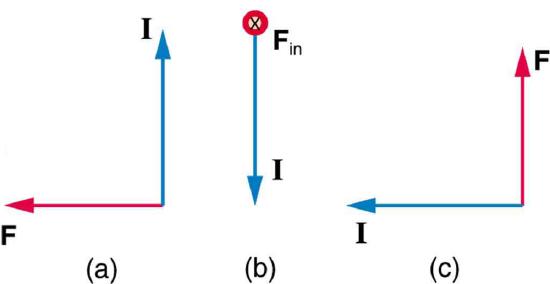
Figure 10.E.11
Solution
(a) into page
(b) west (left)
(c) out of page
31. (a) What is the force per meter on a lightning bolt at the equator that carries 20,000 A perpendicular to the Earth’s 3.00×10−5−T field?
(b) What is the direction of the force if the current is straight up and the Earth’s field direction is due north, parallel to the ground?
32. (a) A DC power line for a light-rail system carries 1000 A. If Earth’s magnetic field at this location is 5.00×10−5 T, what is the maximum possible magnetic force on a 100-m section of this line?
(b) Discuss practical concerns this presents, if any.
Solution
(a) 5.00 N
(b) This is about a pound of force per 100 m of wire, which is much less than the weight of the wire itself. Therefore, it does not cause any special concerns.
33. What force is exerted on the water in an MHD drive utilizing a 25.0-cm-diameter tube, if 100-A current is passed across the tube that is perpendicular to a 2.00-T magnetic field? (The relatively small size of this force indicates the need for very large currents and magnetic fields to make practical MHD drives.)
34. A wire carrying a 30.0-A current passes between the poles of a strong magnet that is perpendicular to its field and experiences a 2.16-N force on the 4.00 cm of wire in the field. What is the average field strength?
Solution
1.80 T
11.10: Transformers
35. A plug-in transformer, like that in Section 11.10, supplies 9.00 V to a video game system.
(a) How many turns are in its secondary coil, if its input voltage is 120 V and the primary coil has 400 turns?
(b) What is its input current when its output is 1.30 A?
Solution
(a) 30.0
(b) 9.75×10−2 A
36. An American traveler in New Zealand carries a transformer to convert New Zealand’s standard 240 V to 120 V so that she can use some small appliances on her trip.
(a) What is the ratio of turns in the primary and secondary coils of her transformer?
(b) What is the ratio of input to output current?
(c) How could a New Zealander traveling in the United States use this same transformer to power her 240 V appliances from 120 V?
37. A digital recorder uses a plug-in transformer to convert 120 V to 12.0 V, with a maximum current output of 200 mA.
(a) What is the current input?
(b) What is the power input?
(c) Is this amount of power reasonable for a small appliance?
Solution
(a) 20.0 mA
(b) 2.40 W
(c) Yes, this amount of power is quite reasonable for a small appliance.
38. (a) What is the voltage output of a transformer used for rechargeable flashlight batteries, if its primary has 500 turns, its secondary 4 turns, and the input voltage is 120 V?
(b) What input current is required to produce a 4.00 A output?
(c) What is the power input?
39. (a) The plug-in transformer for a laptop computer puts out 7.50 V and can supply a maximum current of 2.00 A. What is the maximum input current if the input voltage is 240 V? Assume 100% efficiency.
(b) If the actual efficiency is less than 100%, would the input current need to be greater or smaller? Explain.
Solution
(a) 0.063 A
(b) Greater input current needed.
40. A multipurpose transformer has a secondary coil with several points at which a voltage can be extracted, giving outputs of 5.60, 12.0, and 480 V.
(a) The input voltage is 240 V to a primary coil of 280 turns. What are the numbers of turns in the parts of the secondary used to produce the output voltages?
(b) If the maximum input current is 5.00 A, what are the maximum output currents (each used alone)?
41. A large power plant generates electricity at 12.0 kV. Its old transformer once converted the voltage to 335 kV. The secondary of this transformer is being replaced so that its output can be 750 kV for more efficient cross-country transmission on upgraded transmission lines.
(a) What is the ratio of turns in the new secondary compared with the old secondary?
(b) What is the ratio of new current output to old output (at 335 kV) for the same power?
(c) If the upgraded transmission lines have the same resistance, what is the ratio of new line power loss to old?
Solution
(a) 2.2
(b) 0.45
(c) 0.20, or 20.0%
42. If the power output in the previous problem is 1000 MW and line resistance is 2.00 Ω, what were the old and new line losses?
11.11: Alternating Current versus Direct Current
43. Military aircraft use 400-Hz AC power, because it is possible to design lighter-weight equipment at this higher frequency. What is the time for one complete cycle of this power?
Solution
2.50 ms
44. A North American tourist takes his 25.0-W, 120-V AC razor to Europe, finds a special adapter, and plugs it into 240 V AC. Assuming constant resistance, what power does the razor consume as it is ruined?
45. In this problem, you will verify statements made at the end of the power losses for Example 11.11.1.
(a) What current is needed to transmit 100 MW of power at a voltage of 25.0 kV?
(b) Find the power loss in a 1.00−Ω transmission line.
(c) What percent loss does this represent?
Solution
(a) 4.00 kA
(b) 16.0 MW
(c) 16.0%
46. A small office-building air conditioner operates on 408-V AC and consumes 50.0 kW.
(a) What is its effective resistance?
(b) What is the cost of running the air conditioner during a hot summer month when it is on 8.00 h per day for 30 days and electricity costs 9.00 cents /kW⋅h?
47. What is the average power consumption of a 120-V AC microwave oven that draws 10.0 A?
Solution
1.20 kW
48. What is the average current through a 500-W room heater that operates on 120-V AC power?
49. Two different electrical devices have the same power consumption, but one is meant to be operated on 120-V AC and the other on 240-V AC.
(a) What is the ratio of their resistances?
(b) What is the ratio of their currents?
(c) Assuming its resistance is unaffected, by what factor will the power increase if a 120-V AC device is connected to 240-V AC?
Solution
(a) 4.0
(b) 0.50
(c) 4.0
50. Nichrome wire is used in some radiative heaters. Find the resistance needed if the average power output is to be 1.00 kW utilizing 120-V AC.


